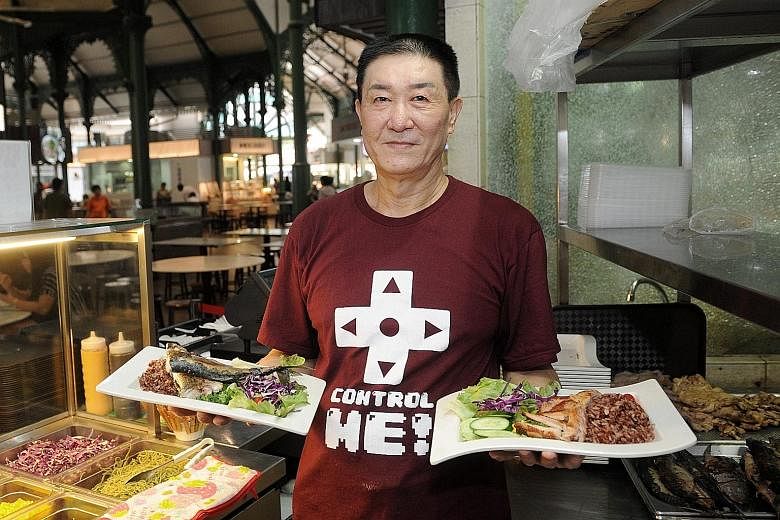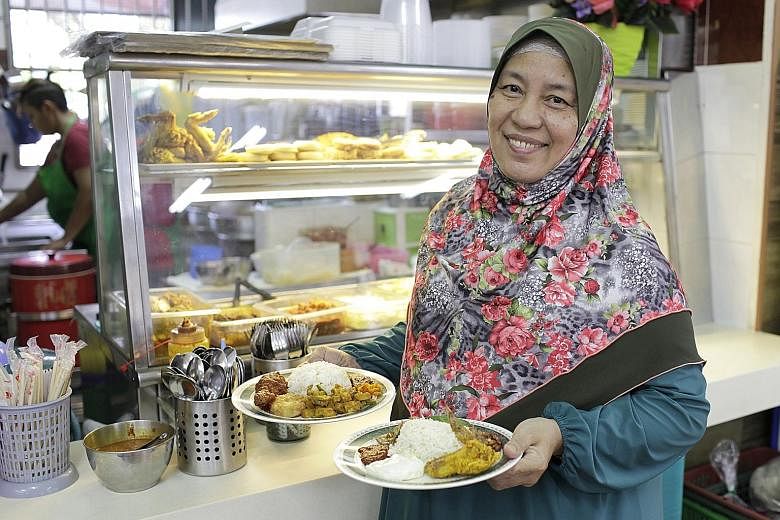Brown is the new white when it comes to the Asian staple, rice. The nutty grain is moving out of the realm of health food and vegetarian eateries, showing up in hawker centres, hotels and restaurants.
Healthy Carbs, a Japanese food stall which opened in February at Lau Pa Sat food centre, serves brown rice sets with teriyaki chicken and saba fish.
At Healthy Kopitiam in Yishun Community Hospital, which opened in December last year, all 10 stalls offer brown rice options for dishes ranging from chicken rice to ayam penyet (smashed fried chicken) to economy rice.
Last month, the Pan Pacific Hotels Group, which runs five hotels including Pan Pacific Singapore, announced that guests can opt for brown rice without extra charge at its restaurants and for room service meals.
Eateries say there is a growing demand for brown rice as diners are becoming more health-conscious.
Brown rice is a type of unpolished wholegrain rice that has its bran layer and germ intact, so that the grains are packed with nutrients such as zinc and iron.
A 200g bowl of brown rice contains four times more dietary fibre and vitamin E, and more than two times the amount of potassium, as the same amount of white rice, says Ms Natalie Goh, 44, chief dietitian of Mount Elizabeth Novena Hospital.
She adds: "Wholegrain foods, like brown rice, contain a higher amount of dietary fibre, which slows glucose absorption from the small intestines into the bloodstream, and promotes satiety, the body's signal to the brain that it is full."
Last month, the Health Promotion Board put the spotlight on the risk of diabetes being heightened by consuming starchy white rice.
Ms Joanna Chan, director of its Obesity Prevention Management Division, says: "In our fight against diabetes, we want to grow the awareness among Singaporeans on the need to improve the carbohydrate quality in our staples, by replacing refined rice and noodles with wholegrain versions."
The board is advocating replacing at least one-fifth of a bowl of white rice with brown rice.
It is also working with food manufacturers and dining outlets to offer more wholegrain options.
Currently, more than half of over 1,600 eateries under the board's Healthier Dining Programme offer wholegrains in their menus.
Following news reports on the war against diabetes, Healthy Carbs got a 20 per cent boost in business. It sells up to 400 rice sets daily.
Its owner Woo Bi Kai, 50, says he decided to offer brown rice to stand out from other Japanese food stalls in the food centre. "My customers, who are mainly office workers, are well-educated on these healthy grains and are starting to get serious about eating them."
Also receiving a business boost is Jumi's Kitchen, a hawker stall in Jurong East, which has been using brown rice in nasi lemak and nasi padang for the past five years.
Its owner Yunaina Taib, 60, steams a blend of white, basmati and brown rice with coconut cream, vegetable oil, pandan leaves and lemongrass. For nasi padang, she mixes white and brown rice. She sells out the 15kg brown rice mix within four hours every day.
However, some customers were initially apprehensive when she tweaked the recipe. "They asked why the grains were harder and looked slightly dirty, but they became used to the taste over the years and like that the rice is less starchy and sticky when left for long hours."
With brown rice found in more dishes, diners should also pay attention to condiments and ingredients. Ms Goh says: "Removing the skin on fried chicken drumstick can reduce fat intake by 40 per cent and having the rice with less gravy reduces fat and sodium intake."
Casual eatery chain Qiji rolled out brown rice lontong earlier this year, after switching to brown rice noodles for dishes such as mee siam and laksa in its 12 outlets last year.
Its retail operations director Chino Lim, 61, says: "While we have encountered resistance from a small number of traditionalists, there was no significant change to our business, which tells us customers are receptive to these healthier versions."
However, not all diners have taken to the taste of brown rice. At Healthy Kopitiam in Yishun Community Hospital, diners pay 30 cents less for their meals if they switch to brown rice or vermicelli.
Despite the incentive, a Kopitiam spokesman says about 14 per cent of patrons take up the option.
Chicken rice cook Zubaidah Muhammad Ibrahim, 52, who works in the hospital foodcourt, says: "Only one-third of my customers choose brown rice as most people are more used to the taste of white rice cooked in chicken stock."
Koji Sushi Bar in Pickering Street offers a 12-grain rice mix that includes brown rice and pearl barley in its rice bowls, such as chirashi don, for an additional $1.
A spokesman says about half the diners choose this option as it can be overwhelming for first-timers. "Eating white rice has been a dining habit for so long," she says. "Unless there's a health motivation or life-changing experiences with brown rice, it will take time for people's attitude towards brown rice to change."
Mr Timur Senturk, vice-president of operations at the Pan Pacific Hotels Group, says there has not been a significant increase in requests for brown rice. But he says the group will consider introducing more brown rice dishes as part of its culinary expansion to cater to more health-conscious diners.
While some diners give the thumbs-up to brown rice options, they say more can be done.
Photographer Melvin Lau, 28, visits chains such as Yoshinoya and Soup Stock Tokyo for his brown rice fix twice a week. He says: "If I feel I have consumed too much sugar and still want a heavy dinner, I will go for brown rice meals and order soup to make the rice less dry."
Businessman Simon Chong, 62, who has diabetes, visits Jumi's Kitchen up to twice a month for its nasi lemak.
"The nasi lemak is not as rich, but I feel less bloated after eating it. However, it is still difficult to have brown rice when dining out and I wish that more economy rice stalls will offer it."



